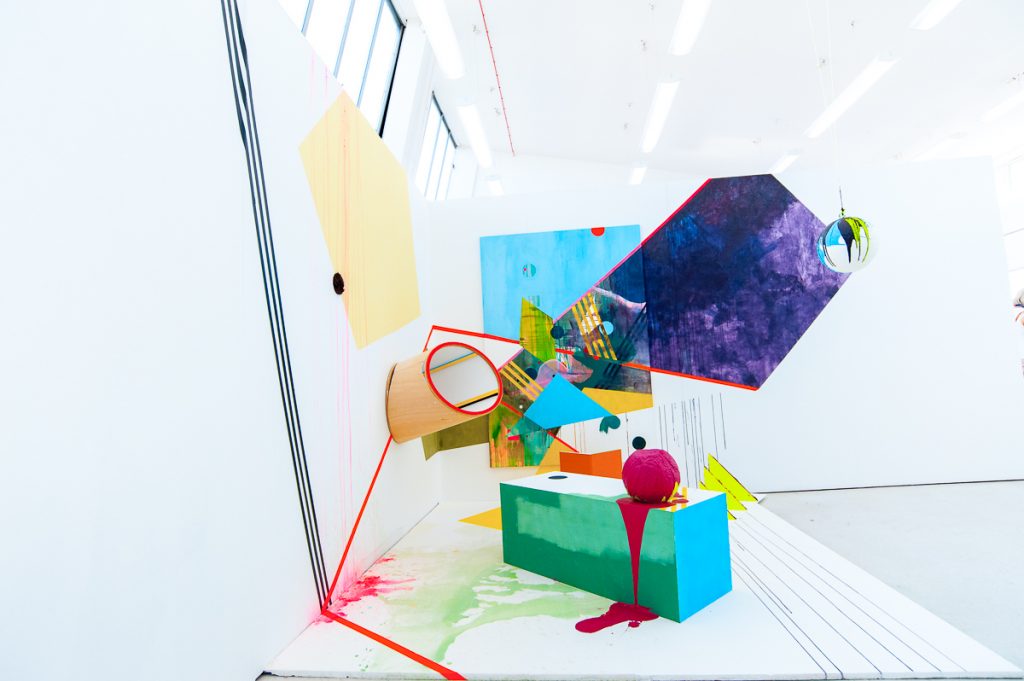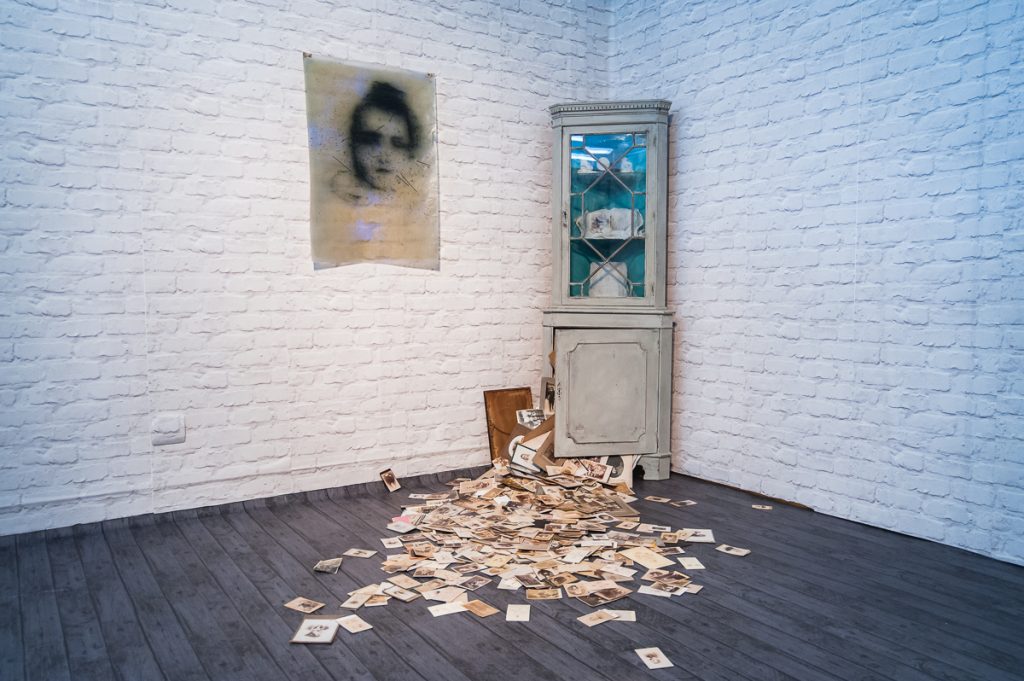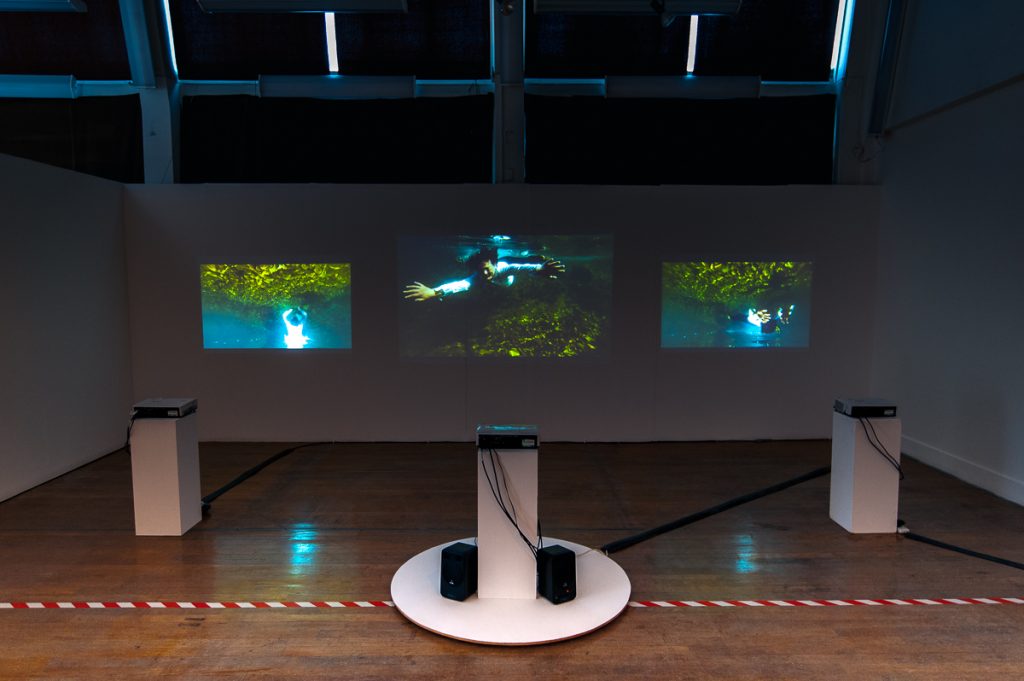DJCAD Masters Show: MFA Art & Humanities – Floor 6

Ginny Elston, “Everything in its Place”.
This was another great chance to see the work of some of the artists involved in the Oscillations project earlier in the year. On Floor 6 of the Crawford Building were Chris Gerrard, Sumit Mondal, Ginny Elston, Amanda Adam, Sharon Mottram and Patricia Ramaer, along with visiting artist Alex Peterson from the University of Minnesota.
Patricia Ramaer’s How Thin the Veils deals with the ephemeral, the dried leaves piled up in a corner of the room as if blown there by the breeze echoed in another corner by a pile of faded sepia photographs spilling out from a display cabinet. The people in the photographs are long since dead; Ramaer shows us that our time on earth is fleeting and that we, like the leaves, are fragile. A series of black and white portrait images, “burned” on to beeswax and tracing paper with carbon, hang around the room. A door is projected on to a curtain – a portal to the next life, perhaps.

Patricia Ramaer, “How Thin the Veils”.
Along the corridor, Sharon Mottram’s powerful collection entitled Encapsulation explores the relationship between drawing and film. Using black ink on white paper, she draws organic shapes that spread out across the page like the branches of a tree. Three large video projections show the artist interacting with nature: swimming underwater, walking through woods, or swathed in feathers. Haunting music accompanies the colour films which complement the starkness of the monochrome drawings.
In the next room, Amanda Adam carries on the theme of nature with her exhibition If Rocks Could Talk – a collection of brightly coloured landscapes and large floor sculptures or “rocks” made of moulded canvas, which seem to possess a playful life force, as if they could start moving at any moment. Photographs and an accompanying film show the “rocks” placed in a real landscape – an unsettling dichotomy of fiction and reality.

Amanda Adam, “If Rocks Could Talk”.
Alex Peterson’s Space Queers//holding-space both shocks and delights. His large figurative pencil drawings are inspired by his love of science fiction; the tongue-in-cheek figures are like faceless superheroes, their features hidden by visors. Peterson describes his work as being “at the intersection of queerness and fantasy, a blend of contemporary illustration and traditional fine art that pushes the boundaries of aesthetic sensibilities and subculture”. His work brings to mind Michaelangelo’s frescos, with a twenty-first century twist.
In the same room, Ginny Elston’s Everything In Its Right Place continues the lighthearted theme with three installations entitled On The Town Trawler, Time Spent Toulouse and Spitting Kisses. Elston plays with texture and fluorescent colours, employing stripes painted on the wall, pieces of fur, giant tennis balls, and even a toaster, a colander and an old cash register make an appearance! Splashes of paint and two dimensional geometric shapes seem to spill over into three dimensions, creating a pleasing fusion of shapes, objects and colours.

Sharon Mottram, “Encapsulation”.
In a room on his own, Sumit Mondal’s Gods and Beings is a collection of brightly coloured gouache paintings on watercolour paper. Heavily influenced by William Blake, Mondal’s work is chiefly based on the ancient art of scroll painting, a tradition in Mondal’s home village in western Bengal. Peasants would go door-to-door with the coloured scrolls, singing songs of gods and goddesses. This highly decorative art form is not widely known outside of the region, so Mondal’s mission is to bring it to the wider world.
Chris Gerrard’s haunting film and sculpture installation seeks to represent the complexities of the human mind with its montages of different thoughts, memories and ideas. Tucked away in the corner of the room is a recreation of the artist’s studio – it is dark and oppressive, the walls seeming to close in around us. It speaks to us of isolation and of the artist confined by his or her own thoughts.
All of these artists have something unique and powerful to say; their work pulls us in and compels us to ask questions, on life, nature and ourselves.
Joanne Morley-Hill

Leave a Reply